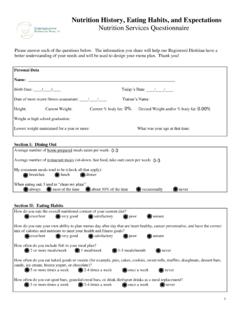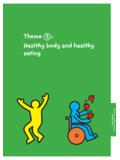Transcription of TECHNICALS LEVEL 3 HEALTH AND SOCIAL CARE
1 10 Nutrition for HEALTH L/507/4427 Guided learning hours: 30 Version 4 September 2017 Cambridge TECHNICALS LEVEL 3 HEALTH AND SOCIAL CARE2016 SuiteLEVEL 3 UNIT 10: Nutrition for HEALTH L/507/4427 Guided learning hours: 30 Essential resources required for this unit: For LO4, learners will need access to an appropriate individual in order to evaluate their diet and nutrition and be able to develop a dietary plan for them. This unit is internally assessed and externally moderated by OCR. UNIT AIM eating is a daily activity for most of us. How does what we eat impact our HEALTH ? What is healthy eating ? How do we promote healthy eating ? As future practitioners, it is important to understand the impact of nutrition on well-being and HEALTH .
2 Rising levels of obesity are leading to increases in heart conditions, diabetes and liver disease. To the NHS, the costs of treating ill- HEALTH caused by poor diet are soaring. Many HEALTH and SOCIAL care practitioners are involved in the provision of meals, so it is important you understand and can explain good nutrition. This unit introduces nutritional HEALTH and the components of good nutrition. You will have the opportunity to scrutinise different foods, consider their HEALTH benefits and investigate how to support other people to impact their HEALTH and well-being. This unit draws on learning from units 2,3,4,6,12,13,14,15,16,17,19, 22 and 23 and can be applied to further understand the impact of nutrition upon the HEALTH and well-being of individuals and their experience of long term physiological conditions.
3 OCR 2017 Unit 10: Nutrition for HEALTH TEACHING CONTENT The teaching content in every unit states what has to be taught to ensure that learners are able to access the highest grades. Anything which follows an details what must be taught as part of that area of content. Anything which follows an is illustrative; it should be noted that where is used, learners must know and be able to apply relevant examples in their work, although these do not need to be the same ones specified in the unit content. For internally assessed units you need to ensure that any assignments you create, or any modifications you make to an assignment, do not expect the learner to do more than they have been taught, but must enable them to access the full range of grades as described in the grading criteria.
4 Learning outcomes Teaching content The Learner will: Learners must be taught: 1. Know nutritional and diet guidelines Dietary intake guidelines: ( eatwell plate, food pyramids, food groups, five-a-day, NHS Change4 Life, healthy eating ) Energy balance, diet and physical activity Nutritional measures ( Body Mass Index (BMI), growth charts, recommended intakes, weight for height and gender, Dietary Reference Values) Food labelling regulations, items on the label required by law nutritional information 2. Understand the functions of nutrients Nutrients, macro nutrients, o carbohydrates, sugar starch non-starch polysaccharides sugar substitutes ( artificial sweeteners, sorbitol) o proteins, polypeptides essential and non-essential amino acids proteins of high and low biological value novel sources ( mycoprotein (Quorn)) o lipids, saturates monounsaturates and polyunsaturates trans fats cholesterol essential fatty acids micro nutrients, o vitamins fat -soluble ( A, D, E and K) water-soluble ( B group, C) o minerals ( iron, calcium, magnesium, sodium, potassium, selenium, zinc) OCR 2017 Unit 10.
5 Nutrition for HEALTH Learning outcomes Teaching content The Learner will: Learners must be taught: energy, o dietary sources o as kilocalories and kilojoules o energy values for protein, fat, carbohydrate and alcohol Functions ( source of energy, muscle repairing and synthesis, supports cognitive function, supports healthy immune system) Dietary needs of individuals, children adolescents adults older people pregnant women and breastfeeding mothers Effects of nutritional deficiencies ( obesity, malnutrition, anorexia, bulimia, undernutrition, rickets, scurvy) 3. Understand factors which influence nutritional HEALTH HEALTH factors ( HEALTH condition ( heart disease, hypertension, diabetes, coeliac disease, irritable bowel syndrome, lactose intolerance, food allergy), loss of ability to feed independently, ( from paralysis, loss of cognitive function)) Lifestyle factors ( eating at home, SOCIAL eating and drinking, exercise/activity levels, occupation (active/sedentary), leisure pursuits) Economic factors ( cost of food, access to shops, food supply, ( seasonal variation)) Sociocultural factors ( beliefs, socialisation, food rituals, role of food in families and communities)
6 Educational factors ( food hygiene, marketing and labelling, public HEALTH , HEALTH education, role of HEALTH professionals, ( dieticians, public HEALTH nutritionists, doctors, nurses, carers, sports nutritionists, HEALTH and fitness instructors)) Personal preference ( meal patterns, snacking, personal tastes, food availability, fast food, takeaways, vegetarianism, veganism) Fluid balance ( dehydration, hyperhydration, superhydration, constipation) Labelling ( Food Standards Agency traffic lights guide) OCR 2017 Unit 10: Nutrition for HEALTH Learning outcomes Teaching content The Learner will: Learners must be taught: 4. Be able to make recommendations to improve nutritional HEALTH Record food intake ( record, over one period of three days, all food eaten including meals, snacks, drinks, confectionery, supplements; portion sizes) Review sources of nutritional information ( tables of food composition, tables of portion sizes, packaging) Quantitative analysis ( to include energy and proportion gained from fat, protein, iron, vitamin C and fibre) Compare to daily recommended intakes ( HEALTH risks related to eating too much or too little of particular nutrients measured to usual dietary habits.)
7 General HEALTH targets ( five-a-day)) Create nutritional plan ( meals, snacks, drinks, guidance on portion size ( numerical amount, weight/volume)) Analyse lifestyle influences ( personal food preferences and requirements, cultural, economic, SOCIAL , availability of time, day-to-day variations ( weekdays/weekends)) OCR 2017 Unit 10: Nutrition for HEALTH GRADING CRITERIA LO Pass Merit Distinction The assessment criteria are the Pass requirements for this unit. To achieve a Merit the evidence must show that, in addition to the Pass criteria, the candidate is able to: To achieve a Distinction the evidence must show that, in addition to the pass and merit criteria, the candidate is able to: 1.
8 Know nutritional and diet guidelines P1: * Describe nutritional and diet guidelines 2. Understand the functions of nutrients P2: Describe the functions of nutrients M1: Analyse the possible effects of poor nutrition for different individuals D1: Evaluate the possible causes of poor nutrition for different individuals P3: * Explain how nutritional requirements differ for individuals 3. Understand factors which influence nutritional HEALTH P4*: Explain factors which influence nutritional HEALTH M2: Analyse the sustainability of a dietary plan for a chosen individual 4. Be able to make recommendations to improve nutritional HEALTH P5:* Evaluate the diet and nutrition of a chosen individual P6:* Develop a dietary plan to improve the nutritional HEALTH of an individual SYNOPTIC LEARNING AND ASSESSMENT It will be possible for learners to make connections between other units over and above the unit containing the key tasks for synoptic assessment, please see section 6 of the centre handbook for more details.
9 We have indicated in this unit where these links are with an asterisk and provided more detail in the assessment guidance section below. OCR 2017 Unit 10: Nutrition for HEALTH ASSESSMENT GUIDANCE LO1: Know nutritional and diet guidelines Learners must be able to describe both nutritional and diet guidelines. For this LO learners will benefit from drawing on learning from mandatory Unit 3 HEALTH , Safety and security in HEALTH and SOCIAL care LO2, Unit 4 Anatomy and physiology LO3, Unit 14 The impact of long term physiological conditions. LO2: Understand the functions of nutrients Learners will be able to give an accurate description of the function of nutrients, and explain how nutritional requirements differ for at least two individuals.
10 For M1 learners must be able to analyse the effects of poor nutrition on different individuals. Additionally for D1 learners must consider the causes of poor nutrition for different individuals. For this LO learners will benefit from drawing upon their learning from Unit 13 Sexual HEALTH , reproduction and early developmental stages LO2. LO3: Understand factors which influence nutritional HEALTH Learners must be able to explain factors which influence nutritional HEALTH . For M2 learners must be able to analyse the sustainability of a dietary plan for a chosen individual (M2 can also be linked to the dietary plan produced for LO4) For D1 learners must produce an evaluation of the causes of poor nutrition for different individuals.














